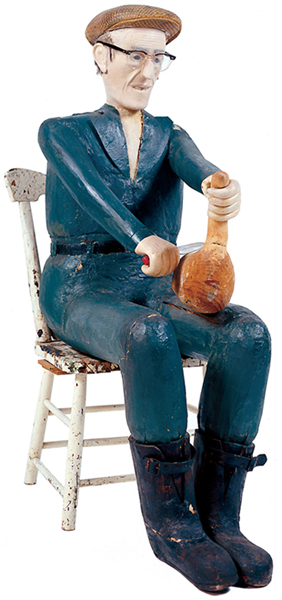Collins Eisenhauer’s Self-Portrait

The career trajectories of artists can vary considerably. Some burn brightly in youth and gradually fade while others reach their zenith later in life. Collins Eisenhauer’s Self-Portrait was made in 1976 when he was 78 and it is arguably his finest work.
Collins Eisenhauer was a Nova Scotian folk artist born in Lunenburg County in 1898. As a child he had a love of art and made drawings and paintings. His father would sell postcards of drawings made by young Collins. Out of necessity, he left school at thirteen and went to work, leaving art behind. When he retired in the nineteen sixties, he decided to spend his remaining years making art. He felt that at sixty-six, he was too old to paint so he began carving wood. He made carvings of people and animals that he painted so that they could withstand the elements. His yard was his gallery, and his friends and neighbours were his audience. A passing antique dealer saw Eisenhauer’s work in the early 1970s and his career as a professional artist began.
Self-Portrait is a life size sculpture of the artist seated and carving a bird with a knife. The work is made of carved and painted wood. Eisenhauer chose to add rubber boots, eyeglasses, hair and a chair to his self-portrait. His inclusion of these “real world” objects in this work and others shows that Eisenhauer was daring, inventive, and in possession of a sharp sense of humour. While in his late seventies, he was expanding his vocabulary of artistic materials, techniques and concepts. Self-Portrait is his most detailed and naturalistic work. He used a mirror to view himself while making it and achieved a degree of realism not seen in most of his work.
Not to take away from his work but, imagine what Eisenhauer may have created with an art education and the means to have an entire career as an artist. He was born the same year as Henry Moore and Rene Magritte. Imagine if he had a studio in interwar era Paris. The Surrealists of that era were influenced by Sigmund Freud and his theory of the unconscious mind. What would they have made of Eisenhauer’s portrait of himself seated, clutching an unmistakeably phallic bird by the neck, and with a knife in the other hand? Eisenhauer may have been untrained as an artist but he certainly knew he was making a bawdy artwork. Along with the birds, deer, cats and figures he carved, he also made sexually explicit drawings, paintings and sculptures. These are not the types of pieces he would place in his yard. They give us a more complex picture of Eisenhauer the person and complicate our expectations of what folk art is.
The Dartmouth born folklorist Helen Creighton was Eisenhauer’s junior by one year. She collected songs and stories she discovered touring the Province, most famously Farewell to Nova Scotia. Her process has been criticized for what she chose to omit because it offended her sense of decorum or presented a more complicated history of the province. She more than likely wouldn’t have recorded a shanty like Stan Roger’s Barret’s Privateers had she come across it.
Folk art is more self-censoring than song. Many artists discovered what would sell and focused on that. Eisenhauer’s geese and swans are beautiful and sought-after exemplars of Nova Scotia folk art. He could have focused entirely on making the things people wanted but there were artworks he made just because he felt the need to. Self Portrait is not sexually explicit in any sense. With this work he achieved a perfect balance between his G rated carvings and the other work hidden away from the public. Eisenhauer is like the joke teller delivering a risqué, double entendre, winking knowingly, and then accusing the listener of having a dirty mind. The grandfather of Conceptual Art, Marcel Duchamp used this ploy many times. When Eisenhauer is referred to simply as, a woodcarver, it fails to recognize what a true artist he was.

